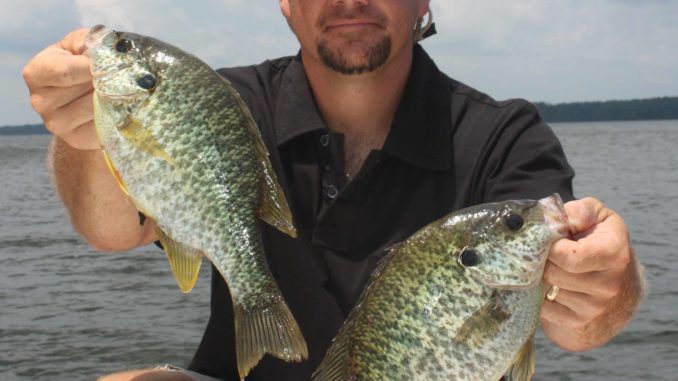
Summer ‘crackers’ hanging around rocks in 10 to 12 feet of water
Shellcracker fishing success isn’t simply reserved for springtime bed-fishing. There’s some outstanding fishing right now for huge shellcrackers at Lake Murray.
According to guide Brad Taylor, the key to catching Lake Murray’s summer shellcrackers is finding rocks.
“A lot of lakes will have different patterns for shellcrackers, but at Lake Murray from now right on through the fall, the rocky humps and ledges around the lake provide ideal cover for the shellcrackers,” Taylor said. “And the size is outstanding, especially for summertime fishing. The average size is around one pound, a hefty shellcracker. But it’s not unusual to catch fish in the 1- and 1 ½- pound-plus class, which are mountable specimens for some fishermen.”
Taylor (803-331-1354) said that some fishing weighing two pounds or better are being caught, but they’re less frequent during the summer. He personally knows of two Lake Murray shellcrackers over four pounds, which puts this lake near the top of the heap for shellcracker fishing in South Carolina.
“Not only do we catch plenty of shellcracker during the summer, on a typical day we’ll catch a mixed bag of fish including bluegill, catfish, white perch and some largemouth bass,” he said. “But the focus is on shellcracker.”
Taylor’s technique is simple and very effective. Using lake maps and his electronics Taylor anchors in six to 12 feet of water on rock piles and fan-casts rigs around the boat. These areas are often close to much deeper water.
“For shellcrackers, I use 10-pound test line; there’s no need to go ultra-light,” he said. “I use a No. 2 Aberdeen gold hook baited with about half a nightcrawler. A few inches above, I clip a No. 7 split-shot, and above that I place a 2-inch slip float that is allowed to slide completely free. The float reduces snags in the rocks. When I reel the baits in to check them or move, the float will enable the line to rise straight up out of the rocks. If I’m in the right type of rocky area, I’ll hang up over half the time if not using the floats.
“I cast these rigs to different depths and areas all around the boat,” Taylor said. “Often, shellcrackers will be in one distinct area. I usually fish an area for no more than 20 to 30 minutes if the action is slow. I use eight rigs, and usually by the time I get them set out, I’m getting bites if it’s going to be a productive place. Once I get a depth pattern, that will generally hold true for that day.”


Be the first to comment